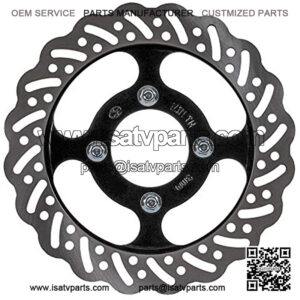The brake system consists of these basic components that all work together:
-
Hand Lever
The rider pulls or squeezes the lever against the handlebar to operate the brakes. Pulling the lever will generally activate the brakes on all four wheels of the bike.
-
Master cylinder
Next to the hand lever on the handlebar, you find the master cylinder. This consists of a small reservoir containing brake fluid and a small piston that works as a hydraulic actuator.
When the hand lever is activated, the small piston pushes brake fluid down the brake line, making it a hydraulic system.
The reservoir should have a gauge to tell the current level of fluid inside. On bikes with the “eye” style indicator on top of the reservoir, a dark center usually means that the reservoir is full. A white center indicates low levels of fluid.
Consult your owner’s manual to learn how to check the level on your specific bike. Make sure it is above the minimum at all times, but do not overfill either. Doing so may cause brake drag or brake lock-up.
-
Brake line
The brake line is a pipe or tube transferring brake fluid from the master cylinder to the caliper on each wheel. The line needs to withstand high pressures and consist of flexible lines or solid steel or copper pipes.
-
Brake fluid
The hydraulic fluid is what makes the whole system work. It’s important to use the right type of fluid for your bike, usually DOT 3 or DOT 4. Notice that if just a tiny amount of air gets into the system, the brakes will not function properly.
-
Brake caliper
On each wheel hub, you’ll find a brake caliper. The caliper is a metal housing containing one or more pistons. It also has the job of keeping the brake pads in place.
- Brake disc
Each wheel has a brake disc that is directly connected to- and spins at the same speed as the wheel. When the brake fluid reaches the piston inside the caliper, the piston is being pushed against the brake pad, which in turn, is being pushed against the brake disc.
The brake pad is made of a material that can handle the friction this creates, making the wheel spin slower.
Hand lever operated disc brakes activate the brake calipers either on all four wheels. Or they activate only on the two front wheels together with one of the rear wheels.
The latter option is true on bikes that rely on the rear diff to have brakes on both rear wheels. Thus needing a caliper on only one of them.
The pressure on all calipers is equal as there is no proportioning valve like you would find on most cars.
About ATV brakes
“atv brakes wont bleed”
“atv brakes squeaking”
“atv brakes locked up”
“atv brakes sticking”
“atv brakes stuck on”
“atv rear brakes sticking”

